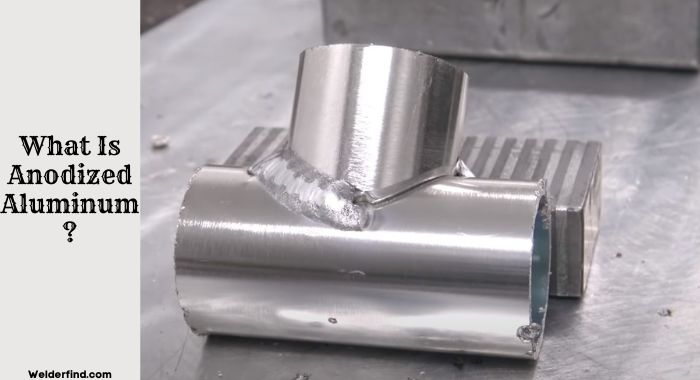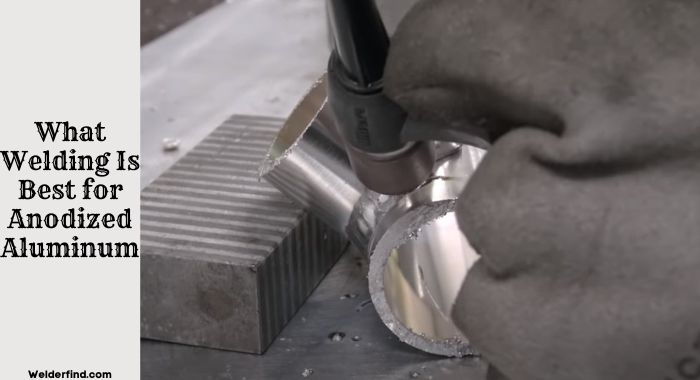Welding aluminum isn’t a complex task at all because many well-known resources are available these days.
But if I talk about welding anodized aluminum, I guess most of you will start scratching your head as the material is lightweight and prone to get cracked sometimes.
So, can you weld anodized aluminum? This is what I’ll talk about today right here. Stay tuned.
What Is Anodized Aluminum?

Among the different types of aluminum, anodized aluminum is known to be a common variant.
Compared to any raw materials, anodized aluminum is 3x harder and, at the same time, 60% lighter than copper and stainless steel.
That said, it’s prone to get cracked after contacting a temperature more than 80-degree Celsius.
This is because anodized aluminum features reduced thermal conductivity. But you will be happy to hear that this material is known for its enhanced durability, cost-efficiency, appearance, and resistance against abrasion.
Can You Weld Anodized Aluminum?
Welding anodized aluminum is possible, but it’s not going to be an easy task for everyone, especially beginners.
For being much lighter than steel and copper, you may find it a bit tough to weld as it may crack in contact with excess heat.
So, to weld anodized aluminum, you can’t apply the typical welding process of aluminum. Also choose a suitable welding machine to start welding that. A Mig welder or a good quality Tig welder would be best for welding this aluminum. Mig welder can be good choice.
What Type Of Welding Is Best for Anodized Aluminum?

I’d say gas tungsten arc welding (GTAW) is an absolute go-to process for anodized aluminum welding.
This particular welding method confirms the precision, adequate balance, and control needed to perform the task safely and effectively.
Moreover, its non-consumable electrodes allow you to bond every join of anodized aluminum in the best way possible, whether colored, bright-finished, hardened, or standard.
All you need is to be well aware of the frequency rate (e.g., 160 – 200 Hz) and the temperature and to collect every essential piece of equipment.
What Are The Things You Need Before Anodized Aluminum Welding?
To weld an anodized aluminum, your first duty should be to collect the right equipment. Don’t use welders that are made for beginners for this project.
A standard air-cooled torch (200 amps) featuring a built-in fingertip, shielding gas consisting of 100% Argon, and a filler metal of 5356-class are some of the must-have components for welding.
As an alternative to pure Argon, you can utilize the mixture of helium and Argon, including a Ceriated of not more than 2%. Using pure tungsten is also a plus if you take assistance from GTAW.
Your power source must be friendly with AC (alternating current). Besides that, having an extra inverter is an advantage to ensuring optimal frequency and balance during a weld.
The inverter will significantly adjust the current speeds in every single part of your current alternative cycle.
To work way faster than usual, seasoned welders often use a higher percentage of negative electrodes.
And last but not least, you must be careful about the frequency rate, which should be around 160 to 200 Hz for optimal outcomes.
How Do You Welding Anodized Aluminum: Step-by-Step Guide
Now that you’ve collected every necessary equipment, you’re just a step away from learning the best and more effective way of welding anodized aluminum.
So go through the following steps:
Step-1: Preparing the Material
This is where you need to clean up the surface of the anodized aluminum you want to weld.
Using a brush or clean cloth, you must eliminate all the nooks and crannies regarding dirt, grease, oil, and such things.
And before you start welding, ensure the aluminum is at room temperature for half an hour or so. In this way, aluminum won’t react with the shielding gas you’ll use and won’t create porosity.
Step 2: Applying the “Bumping” Technique
Through this technique, you’ll do nothing but eliminate the thicker part of the oxide layer from the material, and that too, without offering excess heat.
For this, I’d suggest beginning an arc via the switch of finger control, ceasing the arc after incorporating the filler.
Once you’ve done it, simply move the joint of the weld down within 1/16 inches. Now, repeat the technique for the other joints of anodized aluminum.
Step 3: Switching Off the Fingertip
The title says it all; switching off the fingertip allows the weld pool to cool down before you start heating the spot with a new arc.
For those who are very new or at an intermediate level, it isn’t recommended to cross over 190 amperages. In contrast, a seasoned welder can use 230 amps without any issues.
Step-4: Adding Filler Materials and Start Welding
Picking up the right amp, get your hands on the filler you collected before. Choose the leading edge spot in terms of inserting the filler metal.
Thus, it won’t get trapped throughout the welding process. Have patience during the task and fill each joint of anodized aluminum thoroughly.
Anodized Aluminum Welding Common Mistakes and How to Avoid Them?
Common Mistakes during a Weld:
- Applying too much heat that crosses 80-degree C.
- Inappropriate amperage is one of the significant mistakes made by welders.
- Not keeping the material at room temp before starting the process.
Effective Ways to Avoid Them:
- Maintain a stable heat that doesn’t cross the limit, even if the process takes too much time
- Beginners shouldn’t go over 190 amperages to avoid potential damage.
- To eliminate the porosity issue, keeping the anodized aluminum at room temperature for a certain period is a must.
Wrapping Up
That was all for today about “can you weld anodized aluminum.” Although you can perform it yourself following the above-written steps, I’d still suggest getting practical advice from the experts to complete the task safely.
And don’t overlook the necessity of wearing safety dresses. Good Luck!
